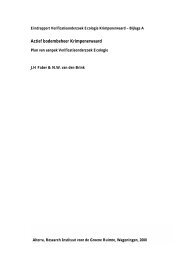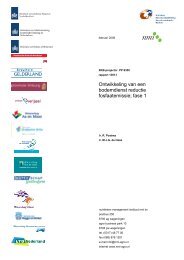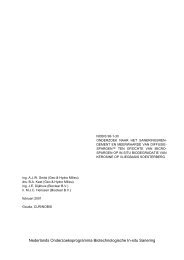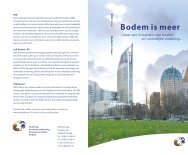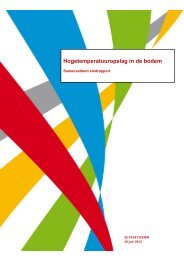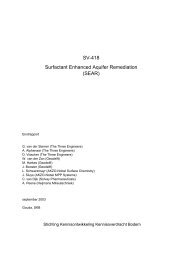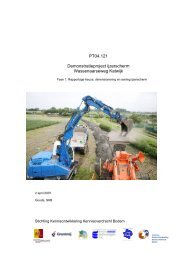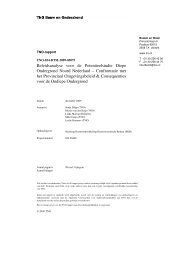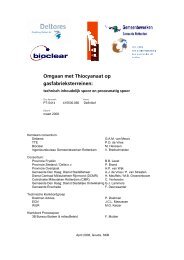Create successful ePaper yourself
Turn your PDF publications into a flip-book with our unique Google optimized e-Paper software.
SUMMARY<br />
Development of an oxygen probe<br />
For some time now, in situ measurements of oxygen have been carried out for scientific research<br />
in the upper soil layers by means of thin to very thin polarographic electrodes. In these scientific<br />
applications the concentration of oxygen is being measured in layers with a thickness of a few<br />
millimetres to a few centimetres. The dimensions of the electrodes are sized to this scale. If a<br />
considerable resolution (0.1 mm) is required in the depth, as well as for the measurement of<br />
photosynthesis activities, glass micro electrodes (Clarck electrodes) are recommendable. Mini<br />
electrodes have been developed to perform in situ measurements of the concentration of<br />
oxygen. This type, where the electrode is placed in a stainless steal needle, is called needle<br />
electrode. Because of their construction, these micro and mini electrodes are unsuitable for<br />
applications in projects related to soil remediation.<br />
In the NOBIS-project 'Imbibition and drainage' a heavier basic prototype was developed on the<br />
basis of the needle electrode, which is characterized by a larger diameter (3 mm instead of<br />
1 mm) and by three sensors placed into the same electrode instead of one. The electrode is applied<br />
in combination with an Edelman-bore. The electrode is put into the borehole and pushed<br />
into untouched soil. After stabilization the signals can be read. With this basic prototype,<br />
promising test results were obtained during the project 'Imbibition and drainage'. The purpose of<br />
this project is the development of prototypes of in situ oxygen probes, including the corresponding<br />
system for data logging and software, for the characterization and monitoring of oxygen<br />
contents in the soil.<br />
The basic prototype was tested extensively in the field at approximately 10 locations with<br />
different soil structures. The results showed that a lot of the measurements gave a clear tendency<br />
towards decrease of the oxygen content in the depth. Also, detection of the zero concentration<br />
was not a problem. However, during the measurements also some disadvantages<br />
appeared. The problems encountered were not caused by the principles of the electrode but by<br />
its technical construction.<br />
It can be concluded that although the basic prototype of the oxygen electrode is a measuring<br />
instrument with strong potentials, in the present construction it is only limited suitable for the<br />
characterization of soils in regard of the distribution of oxygen.<br />
Recently, a new possibility for the in situ measurement of oxygen has been presented, by means<br />
of an optical sensor. The coating of a glass fibre is being stimulated by light to fluorescence.<br />
Oxygen causes the fluorescence to extinguish. Until now it was possible to measure the content<br />
of oxygen for example by means of a phase shift of the light compared to a reference (which<br />
requires a considerable amount of measuring electronics) or by the absolute level of the new<br />
signal (which leads to erratic measuring results in case of damage). Van Essen Instruments and<br />
TNO have filed a patent application for a newly developed measuring method with an optical<br />
electrode, which combines the advantages of both mentioned measuring methods but overcomes<br />
the disadvantages. This sensor is expected to be operational at the beginning of 2000.<br />
On the basis of a written survey under potential users of in situ measuring instruments (data file<br />
NOBIS/NOVEM) lists of demands have been drawn up for the instruments to be developed for<br />
characterization and monitoring. These lists should indicate with which specifications the in situ<br />
measuring instruments of oxygen in the soil have to comply, so that - within the boundary con-<br />
viii



